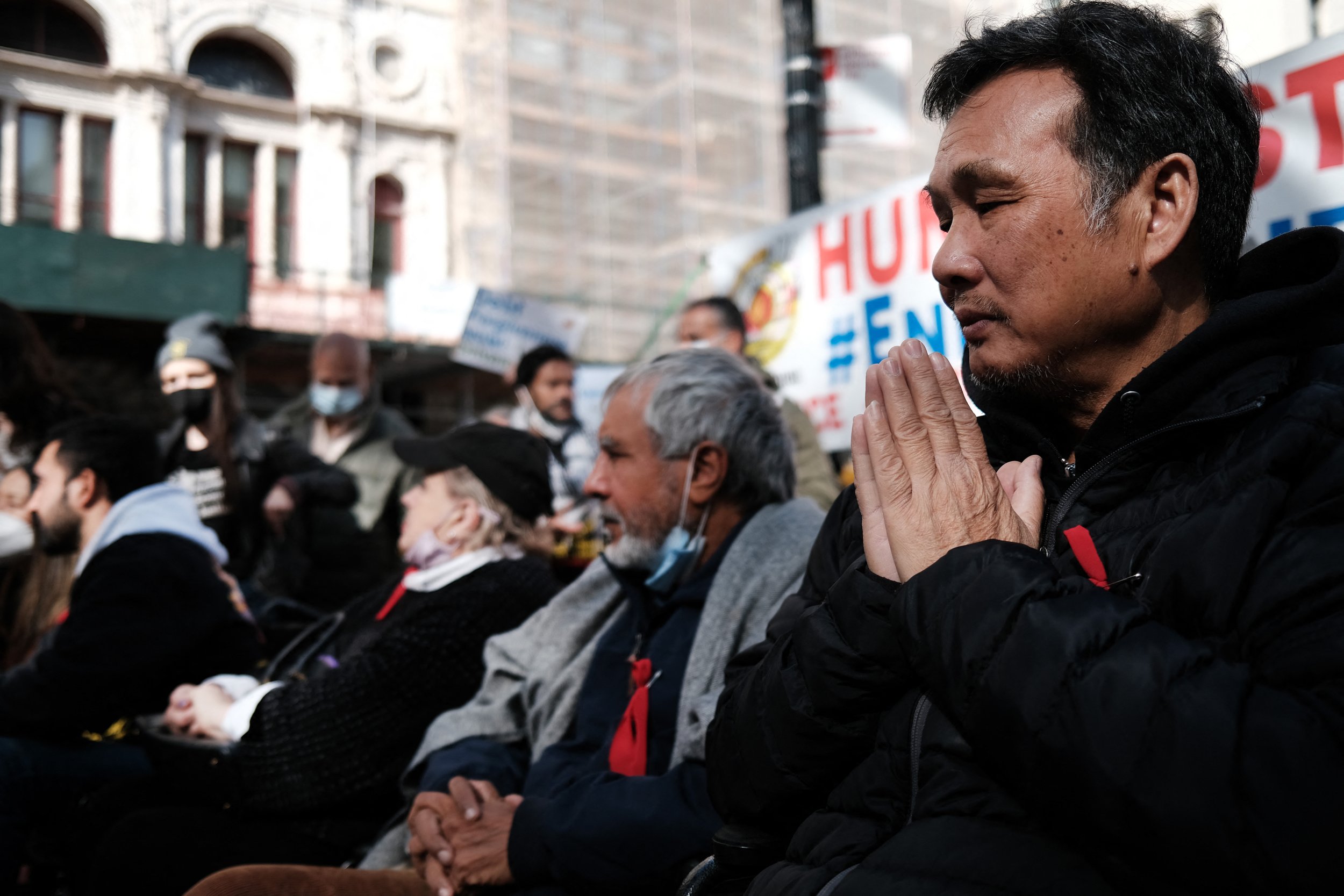Starving for Justice
New York City taxi drivers and their supporters during a hunger strike for debt relief outside City Hall in Lower Manhattan on October 31, 2021. [Spencer Platt/Getty Images via AFP]
Would you starve yourself for justice?
This was the question I asked myself last year when New York City taxi drivers undertook a hunger strike to fight for relief from overwhelming debt. In doing this, they were joining a long political tradition: Late Irish Republican Army leader Bobby Sands and Palestinian prisoner Hisham Abu Hawash are among the political activists and prisoners worldwide who have used hunger strikes to advocate for better conditions for themselves and those with whom they stand in solidarity.
To better understand this tactic, I interviewed Nayan Shah, professor of American studies and ethnicity and history at the University of Southern California and author of Refusal to Eat: A Century of Prison Hunger Strikes.
What can be achieved, he asks, through “projecting the possibility of one's life and death?”
Here are five takeaways from our conversation.
The body can communicate
“At the very core, the refusal to eat while in prison is to use your body’s deprivation to fight the conditions which are put [upon it] and marry it to a political cause,” Shah said. He emphasizes that strikers “[marshal] the human body to communicate over prison barricades to the public.” Strikers then rely on lawyers, advocates and family to transmit their experiences.
Strikes require preparation
Shah was struck by the strategies that hunger strikers use to calm their minds and impulses, and to mitigate their hunger and physical transformation. Some practice deprivation, go on extended fasts, or even undertake short-term hunger strikes in order to build endurance before embarking on the long one.
Strikers “prepare for the gnaw and pain of hunger, for the weakness, dizziness and listlessness, for the experience of constipation, for the threats and entreaties from wardens, guards, doctors and family members to resume eating,” he said, noting that some will also “try to forestall dehydration by drinking water (with salt).”
Strikers also have to learn how to support each other and maintain solidarity, especially while being physically isolated. “The hunger strike can break because people disagree, and might actively undercut each other because of their own sense of despair,” Shah said.
Strikers turn state violence on its head
“Food – its preparation, its delivery schedule, its withdrawal – is central to the structuring of prison operations. So the hunger strike actually creates an upheaval in the prison itself and the way it's organized,” Shah said.
Hunger strikes are different from other forms of protest because they “don’t cause material harm to an adversary,” Shah said. Instead, they create an “alarming exposure of the striker to suffering … It's a jiujitsu move in a way because it begins to foist responsibility for the strikers’ self-destruction onto the state's authority.”
Doctors and nurses’ ethics are rooted in solidarity
Prison hunger strikers are often subjected to forcible feeding, an ugly process that can bring attention to the violent means that prisons use to control their wards.
In the U.S., Shah said, medical associations have not historically considered forcible feeding comparable to assisting people who can’t eat. To underscore this point, he singled out a letter written by the American Medical Association to former defense secretary Chuck Hagel, and another by the International Council of Nurses to the U.S. Navy, both criticizing the practice of force-feeding Guantanamo Bay prisoners in 2013 and 2014.
“People have said that life preservation at all costs is really the idea here. And that this person could be considered suicidal and depressed, and that's why they're [being force-fed] … This is a confrontation ethically for physicians and nurses who increasingly do not want to be engaged in forceful feeding,” Shah said. Though strikers who have been moved to hospitals might be persuaded to eat and rehydrate, the ethical question is whether they feel as if they’ve given their consent.
It’s not about death, but about the fight to live
“We often focus on the hunger strikers who may have perished … but most hunger strikers are survivors,” Shah said. “What many hunger strikers see is not just that they have endured a period of hunger strike, but that they're actually people who have and want to embrace a life beyond [the strike], whether that continues in prison or in detention.”
“[Hunger strikers] want to see a different world than the one that exists and they’re willing to court their death to do that,” Shah said. “They are courting the idea of dying as a way of talking about the conditions of their living.”
“Strikers have to have some degree of astonishing hopefulness [about whether] it's possible to breach the barriers outside,” Shah said. To feel as if “they can reach people outside and people will care, they have to believe in the powers of communication [through] their body, and that ... their actions will be something that's going to influence other people to respond.”




